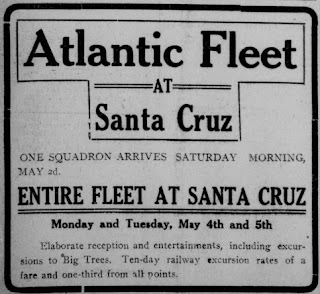 |
| Sacramento Union, April 24, 1908 |
In May 1908 Santa Cruz hosted the "Great White Fleet." The term was a nickname for the U.S. Atlantic Fleet that made the first around-the-world cruise by a contingent of steam-powered steel battleships. The forty-three-thousand-mile, fourteen-month circumnavigation was the idea of President Theodore Roosevelt to display American naval dominance of the seas and remains one of the greatest achievements of the peacetime navy.
The land-starved sailors, marines and officers of the fleet were invited to picnic at Big Trees Grove; an invitation they accepted with great joy. Happily, Herman and Joseph Welch, Jr. consented to waive the 25 cents per person entrance fee for all fleet members.
The land-starved sailors, marines and officers of the fleet were invited to picnic at Big Trees Grove; an invitation they accepted with great joy. Happily, Herman and Joseph Welch, Jr. consented to waive the 25 cents per person entrance fee for all fleet members.
In my book, Historic Tales of Henry Cowell Redwoods State Park - Big Trees Grove, I give a detailed account of the fleet's visit in the chapter entitled, "Bluejackets and Jack Tars." The cover of my book is graced with an extraordinarily clear image showing a throng of fleet sailors and local townsfolk standing among the Fremont Group. This outstanding image is from the Special Collections of the University of California, Santa Cruz. The panoramic image was taken by Arthur C. Pillsbury, who was best known for his landscapes of Yosemite and the San Francisco Earthquake. Only a portion of Pillsbury's fleet image is shown on the cover, but within my book you can see the entire panoramic image. For further information about Pillsbury and his work you may visit the Arthur C. Pillsbury Foundation at www.acpillsburyfoundation.org
There were some additional images of the fleet's visit which I located in newspaper accounts. I
have yet to locate the originals of these images. If anyone might know
their whereabouts, I would greatly appreciate knowing.
These images appeared in the May 5, 1908 San Francisco Call article by W. Russell Cole entitled, "Fleet is Again in One Array."



